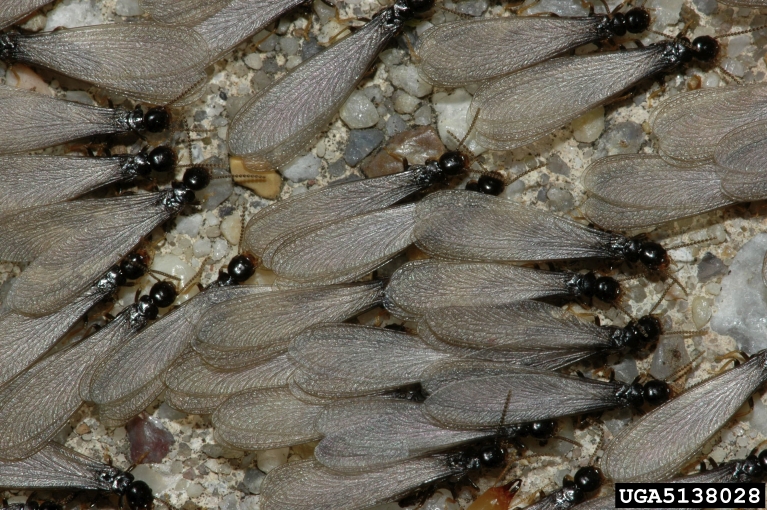
by Mary Salinas | Apr 29, 2020

Swarm of eastern subterranean termites. Photo by Susan Ellis, Bugwood.org.
Spring is in the air and that means termite swarming season is near!
Northwest Florida is home to fifteen native species of termites and six species that have invaded from other parts of the world. One invasive species of termite, the Formosan termite, arrived in the southeastern United States in the 1950’s and has been expanding its range and numbers ever since. While our native termites have colonies in the thousands of individuals, Formosan termite colonies can contain millions of individuals and that makes them a greater threat if they invade your home.
Here are some steps you can take to protect your home:
- Turn off outside lights during termite swarming season – late April through June – the swarms are attracted to the light and may then find entry into your home.
- Reduce moisture around your home by keeping gutters clean and having them drain at least a foot away from the foundation.
- Avoid irrigation hitting the house.
- Plants and mulch should be a foot away from the foundation.
- Repair leaks and cracks – termites can get into the smallest of spaces.
- Avoid wood, stucco and siding in contact with the ground.
- Have an annual inspection by a licensed pest control company. Read the fine print of what is covered and what species/type of termites are included. Some policies exclude coverage for Formosan termites.
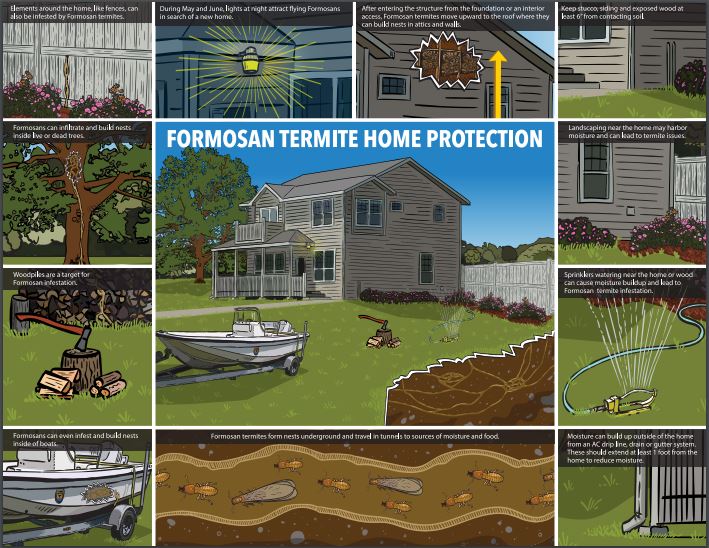
For more information:
Subterranean Termites
The Facts About Termites and Mulch
UF/IFAS Featured Creature: Formosan Termites
Florida Department of Agriculture and Consumer Services Termite Control Information
Florida Department of Agriculture and Consumer Services Formosan Termite Program
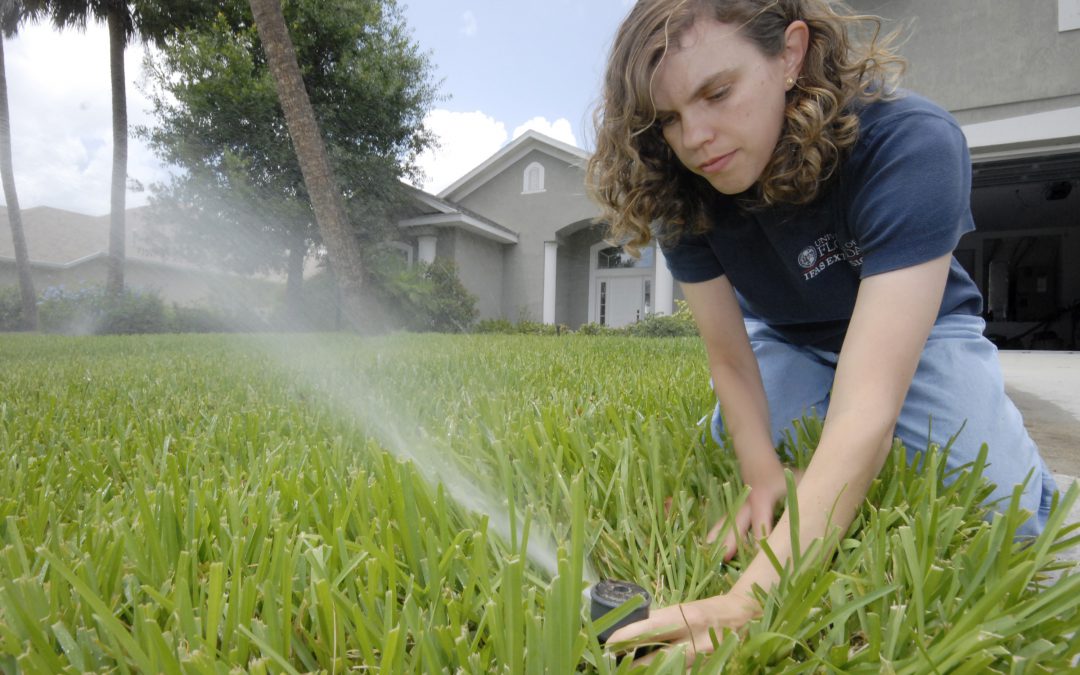
by Mary Salinas | Apr 1, 2020
With our warm weather, many homeowners are looking to create a beautiful lawn for the year. There are so many products in the home improvement stores and nurseries that promise to make your lawn into a green paradise. What to choose?
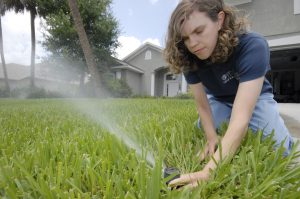
Photo UF/IFAS Extension. Spring is a good time to check the water flow and direction of a pop-up irrigation system and make adjustments as necessary.
UF/IFAS Extension provides advice based on scientific research. This is what the science says:
- Wait to apply lawn fertilizer in north Florida until mid-April. Lawn grasses don’t have sufficient root growth and capabilities to use the fertilizer until then. Applying fertilizer earlier in February and March feeds the winter weeds or is lost to leaching down into the soil below the grass roots. Here’s more detail on fertilizing your lawn.
- Weed and feed products are not recommended. Instead, spot treat weeds when they are small before they mature and set seed. Consult our Weed Management Guide.
- Preemergence herbicide, if applied correctly, can cut down on the weeds. Apply in late February or first of March for summer weeds and October 1 for winter weeds. Now in late March – Early April is still a good time to use a preemergence herbicide for those weeds that have not yet sprouted. It is crucial to apply the product correctly, following all label directions. Measure your lawn and make sure the right amount of product is applied. This is a convenient way to measure your lawn from your armchair.
- Sharpen your mower blades! A clean cut on the grass blade cuts down on lawn stress and diseases setting in.
- Water efficiently. We see more damage to lawns from overwatering than underwatering. Overwatering leads to increased weeds, disease, insect pests and weakens grass roots. Lawns need ½” to ¾“ of water and this will tell you how to determine when to water. The root system is healthier and stronger when watered deeply only when it needs it. Learn how long it takes your sprinkler system to deliver that amount.
The University of Florida provides more advice and information at:
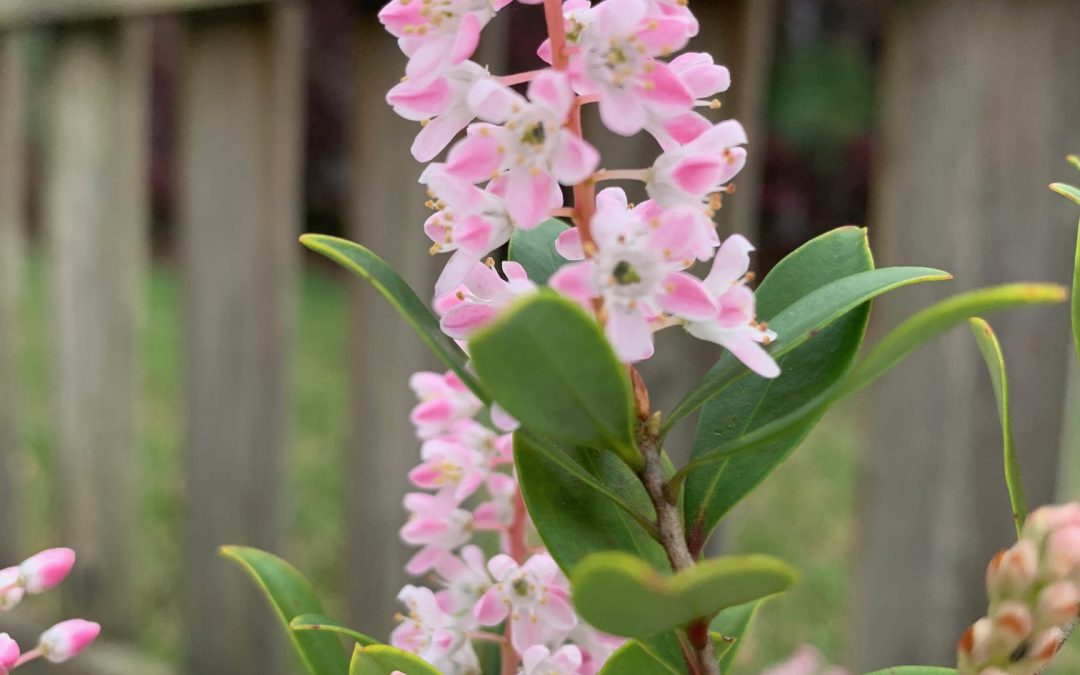
by Mary Salinas | Feb 18, 2020
Florida is home to some amazing and gorgeous plants that are underused and underappreciated in the home landscape. One such plant is an evergreen and easy-care large shrub or small tree known as black titi or buckwheat tree, botanically known as Cliftonia monophylla.
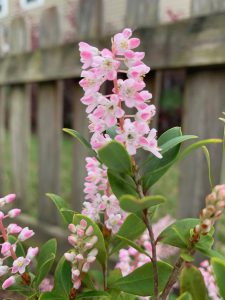
Pink-flowered variety of black titi, Cliftonia monophylla. Photo credit: Mary Salinas, UF/IFAS Extension.
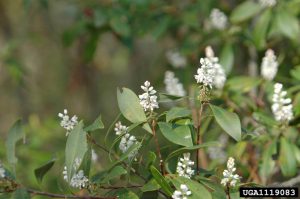
Black titi or buckwheat tree. Photo credit: Chris Evans, University of Illinois, bugwood.com
Black titi is commonly found in wet areas and at the edges of swamps in USDA hardiness zones 7B through 9A from Louisiana through the Florida panhandle and into South Carolina. This is a perfect plant for those areas of your landscape that are low and consistently moist.
Early spring brings clusters of small white flowers at the tips of the branches. Occasionally one can find the pink-flowered variety of black titi in the native nursery trade. These fragrant flowers provide an early season nectar source for bees in February and March. The flowers give way to golden-amber seed pods that resemble buckwheat. The seed pods turn a pleasing orange-brown and persist on the plant through winter. The shiny dark green evergreen leaves along with the seed pods provide an additional ornamental quality to the tree in fall and early winter.
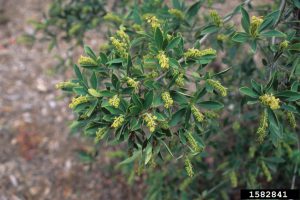
Black Titi golden-amber fruit. John Ruter, University of Georgia, bugwood.org
For more information:
Florida Honey Bee Plants
USDA Plant Database
Florida Native Plant Society
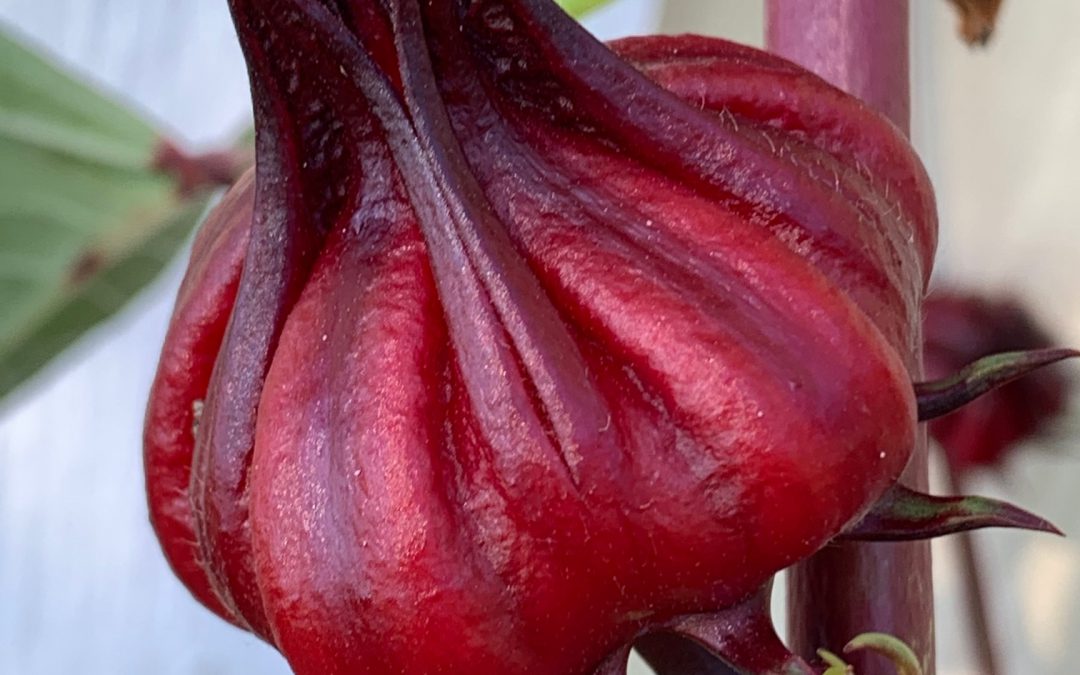
by Mary Salinas | Dec 4, 2019
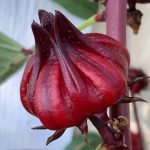
Attractive roselle fruit. Photo credit: Mary Salinas, UF/IFAS Extension.
Just before the recent cold weather I harvested seed pods from my roselle, Hibiscus sabdariffa, and made the most delicious and nutritious iced herbal tea.
You may have heard other names for this plant of Asian or African origin: bissap, red sorrel, Indian sorrel, Jamaica sorrel, Florida cranberry or jelly okra. Whatever name you call it, it has been grown in Florida since the late 1890’s.
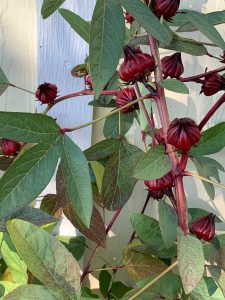
Roselle leaves and fruit. Photo credit: Mary Salinas, UF/IFAS Extension.
People around the world enjoy consuming roselle in many ways. In addition to making a beverage from the fleshy fruit, it is used to make jams, jellies, relishes, syrup and added to salads. Harvest the fruit when it is large (as in the photo) but before it gets tough. Leaves can be eaten raw in salads or cooked into dishes. Even the seeds can be made into a high protein meal or ground into a coffee substitute.
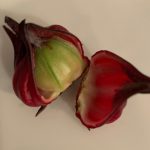
Roselle fruit showing the unripe green seedpod surrounded by the fleshy calyx. Photo credit: Mary Salinas, UF/IFAS Extension.
My lone roselle plant provided hundreds of fruits and was so easy to grow. In the spring it started as a small 3-inch seedling and by November it grew to over 4 feet tall and wide. Roselle can grow 6 to 7 feet tall. It’s not too picky on soil type if it gets plenty of sun and consistent moisture. Few pests are attracted to roselle. However, deer will eat this down to the ground, as they will any hibiscus. Since my garden is plagued by hungry deer, I placed the roselle in the back of a landscape bed with a border of plants unappetizing to the deer. Expect roselle to start blooming in mid-summer and continue through frost. Blooms only last one day before forming the equally attractive fruit.
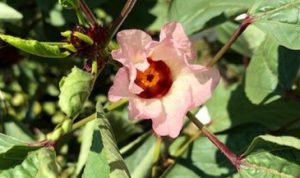
Roselle flower. Photo credit: Sally Menk, Florida Master Gardener Volunteer.
Roselle is a tropical plant and susceptible to frost in northwest Florida. To have seeds for next year, let some of the fruit stay on the branches to let the seed pods turn yellow/brown and ripen. There are also many online seed companies that carry seed.
For more information:
UF IFAS Gardening Solutions: Roselle
More on Roselle from Purdue Extension
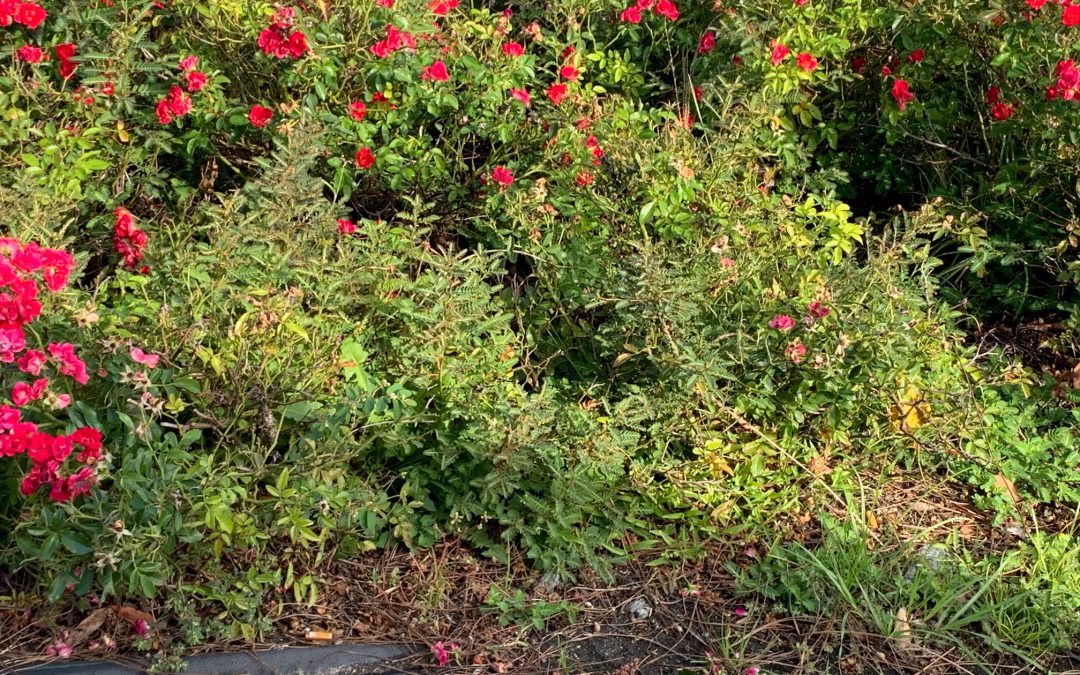
by Mary Salinas | Oct 22, 2019
Gardeners are always fighting the endless weeds that pop up in landscape and flower beds. When homeowners put in a new landscape bed and want to prevent future weed invasions, many think that putting down landscape fabric is a great way to keep the weeds from emerging and protect the newly planted trees, shrubs or perennials.
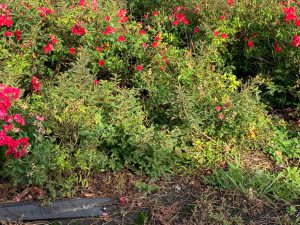
An example of failure of landscape fabric to control weeds less than 2 years after planting. Note the peeking through at the edges. Photo credit: Mary Salinas, UF/IFAS Extension.
Is Landscape fabric a good choice? Why or why not?
If landscape fabric is not covered up, sunlight will degrade the fabric. When mulch is placed on top of the fabric (and we all do want to cover it up – the fabric is not very attractive) the mulch breaks down into soil. Inevitably, weed seeds blow in and settle and germinate and grow on top of landscape fabric. And here you are with a weed problem. Weeds also find their way into the openings cut for desirable plants and along the edge of the fabric.
Landscape fabric is porous when put in place to allow water to pass through, but as time passes, the pores can get clogged and water penetration is restricted – rain and irrigation runs off and the plants you meant to protect are not getting the water they need.
Maybe the worst effect is that the landscape fabric creates unfavorable soil conditions. A healthy soil is key to good plant health. One thing soil needs to have is an exchange of carbon dioxide and oxygen between the soil and the atmosphere. Recent studies from Washington State University demonstrated that gas movement between the soil and the atmosphere is restricted about 1,000 times more when landscape fabric is present than when areas have only wood mulch.
So, if landscape fabric is not a good choice, what is?
Mulch made from wood, bark, fallen leaves and pine needles. See Gardening Solutions: Mulch for sustainable ideas.
For more information:
Improving Weed Control in Landscape Planting Beds
















